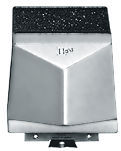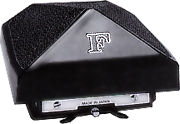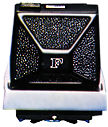|
Modern Classic SLRs Series :
Nikon
F - Viewfinders
|
| |
 |
Action Prism
The basic concept of
this finder was so sound that it spawned a couple of copies (the notably innovative
Canon Speedfinder and the Pentax FK-1 LX finder) and has produced its own progeny
(DA-1 for F2, DA-2 for F3, DA-20 for F4, and now DA-30 for the F5, to say nothing
of the Nikonos RS, which is basically a N4004 [F401] with an action prism and a massively
sealed casing) in the Nikon line.
|
It provides less
magnification (0.6x versus 0.8x) than the standard finders, but allows the user to
hold the camera up to about an inch and a half (40mm) from the eyepiece and still
view the entire screen. So who needs one? They are extremely popular for use in underwater
housings, when you have to deal with the additional bulk of the mask and housing
between you and your camera. It provides an upright, unreversed view: think of it
as a super-HP finder, and you won't be far off. I have heard that they are occasionally
difficult to view in bright (side) light, as the image may be washed out without
your head to act as a shade for the eyepiece.
 |
Some numbers for you gearheads
out there: the prism stands 41mm above the top plate (when mounted); the front sticks
out 20mm beyond the "Nikon" plate, the total depth is 72mm, and width is
48mm. It weighs 10.5 oz. The entire field is visible when the eye is up to 60mm behind
(axially) the eyepiece; when the eye is 20mm behind, you may move up to 16mm vertically
and 24mm horizontally and still see the entire field. The eyepiece is rectangular,
32 by 26mm.
|
Eyelevel Finder
- No frills. No relaxed eyepoint
(yes, left-eyed glasses wearers, scratch your right lens on the rewind lever like
me); no hotshoe on top. There isn't even the exciting eyepiece LED that the DE-1,
the F2's eyelevel finder, offers. Who wants it? Imagine looking through the viewfinder
and seeing your picture floating on top of an undistracting black background: no
flashing lights, no exposure readouts, no focus confirmation, no dancing needles,
nothing at all to keep you from concentrating on getting the composition that you
want. Yes, it forces you to use a more deliberate style and actually consider what
your picture, but it is wonderfully simple and unintrusive. Nikon F's that come with
the eyelevel prism, despite being the cheapest to buy when new, are now among the
more expensive. This is partly due to the rate of failure of the metering mechanisms
(which often work great as finders, still, although with the added distraction of
having the somnolent meter needle and some exposure information). If you are buying
a prism finder, remember that the vast majority were sold to photojournalists, who
used hand-held meters, and so may not be in great cosmetic condition: you want to
check that there is no physical damage to the prism inside, i.e. desilvering, prism
separation, etc.
 |
The Nikon F with an eyelevel
prism is one of the most crisply designed, cleanly styled cameras ever made. It is
at once distinctive and elegant, and for those of you who have seen nothing prettier
than the slightly lumpy (for my tastes) EOS or Nx00x series, you owe it to yourself
to gaze upon the forerunner of modern 35mm SLRs at least once a day.
|
Shown above is
the Black Chrome version. Standard eye level finder is chrome white. Along with the
choices of the matching Nikon F body, which came with satin chrome white or black
version.
Waist level Finder
These came in two versions,
an earlier 3-sided (and more common) version, and a 4-sided (after the F2's introduction)
version. Both are conventional waist-level finders, with lids that flip open to view
the screen and a 3x magnifier (which may be moved aside) to allow for better focussing.
 |
They are the cheapest and probably
least capable of the F's viewfinders, probably because whenever most people need
a waist-level finder (WLF), they employ the poor man's (sorry, could just as easily
be poor woman's) trick: remove the finder currently in place and voila! your own
WLF, although without the hood (helps screen contrast on bright days) or magnifier.
Credit: Images(s) courtesy of Mr.Imre dePozsgay <imre@rclcameras.com>
from www.RCLcameras.com
|
-
 |

|
Either way, whether you use
the Nikon WLF or "make your own", the image is unreversed and erect (i.e.
as you view the world -- it has to do with the mirror's position relative to the
lens, which reverses and inverts the image).
|
6x Magnifying
Finder
- Conventional wisdom has
it that Nikon never offered the 6x finder for the F separately. However, if you ever
have the need, the F2's DW-2 fits perfectly, if you remove the front plate which
says "Nikon" (or "Nikkor", if you are so lucky). Although this
finder allows you to view the entire frame without moving your eye and provides and
unreversed, erect image, it is really best suited for precision work (i.e. macrophotography,
perhaps some wide-angle landscape work, although most landscapes are taken with panoramic
medium format beasts, like the Fuji GX617, or with monorails). A nice bonus is the
built-in diopter adapter.
|
Next | The
Metered Prisms for the Nikon F
|
Back | to Index Page - Finders/Prisms

Main Reference map in HTML
& PDF:
Body
with FTN Finder
| FTN finder | camera body |
External
links
for F & F2
-
|
Back | to Nikon-F - Main Index Page
Michael
C Liu's Nikons Classic Site
Other
Nikon F Variations
Nikon Auto Focus Nikkor lenses:-
Main Index Page
Nikon Manual
Focus
Nikkor lenses:- Fisheye-Nikkor Lenses - Circular | Full Frame |
Ultrawides Lenses - 13mm15mm18mm20mm | Wideangle Lenses - 24mm28mm35mm | Standard Lenses - 45mm 50mm 58mm | Telephoto
Lenses - 85mm105mm135mm180mm & 200mm | Super-Telephoto Lenses - 300mm 400mm 500mm 600mm 800mm 1200mm |
MF Zoom-Nikkor Lenses: 25~50mm | 28~45mm | 28~50mm | 28~85mm | 35~70mm | 36~72mm E | 35~85mm | 35~105mm | 35~135mm | 35~200mm | 43~86mm | 50~135mm | 50~300mm | 70~210mm E | 75~150mm E | 80~200mm | 85~250mm | 100~300mm | 180~600mm | 200~400mm | 200~600mm | 360~1200mm | 1200~1700mm
Tele-Converters: TC-1 | TC-2 | TC-200 | TC-201 | TC-300 | TC-301 | TC-14 | TC-14A | TC-14B | TC-14C | TC-14E | TC-16 | TC-16A | TC-20E
Recommended links to understand more technical details
related to the Nikkor F-mount and production Serial Number:
http://www.zi.ku.dk/personal/lhhansen/photo/fmount.htm by: Hansen,
Lars Holst
http://www.mir.com.my/rb/photography/hardwares/nikonfmount/lens2.htm
http://www.photosynthesis.co.nz/nikon/serialno.html
| Back | to Pictorial History of Nikon SLR / rangefinders
/ Nikonos / digital cameras.
 |
|
| Message
Board
|
for
Nikon
F
Series SLR Camera(s)
| Message
Board
| for
your Nikon Optics in a shared environment
| Message
Board
| Specifically
for Dispose or
Looking for
Nikon/Nikkor Photographic Equipment |
|
Modern Classic SLRs Series :
Nikon
F - Index
Page
|


Copyright
© 1998. Michael C. Liu ®
Site
rearranged by: leofoo ®.
Credit: Hiura Shinsaku® from
Nikomat Club of Japan for feeding some useful inputs on the introductory page.
The great 3D logo by Kiasu; Ted Wengelaar®,
Holland for his continuous flow of input of early Nikon bodies. Stephen Gandy's Cameraquest; Marc Vorgers from Holland for
his additinal images on Nikon F Apollo; Hayao Tanabe
corrected my Red Dot and Early F assertions. Gray Levett, Grays of Westminster
publishes an excellent monthly historical look at Nikon products, from where I learned
about the high-speed F's. Made
with a PowerMac, broadcast with
a Redhat Linux
powered server.
 |
Home - Photography in Malaysia
|
 |







